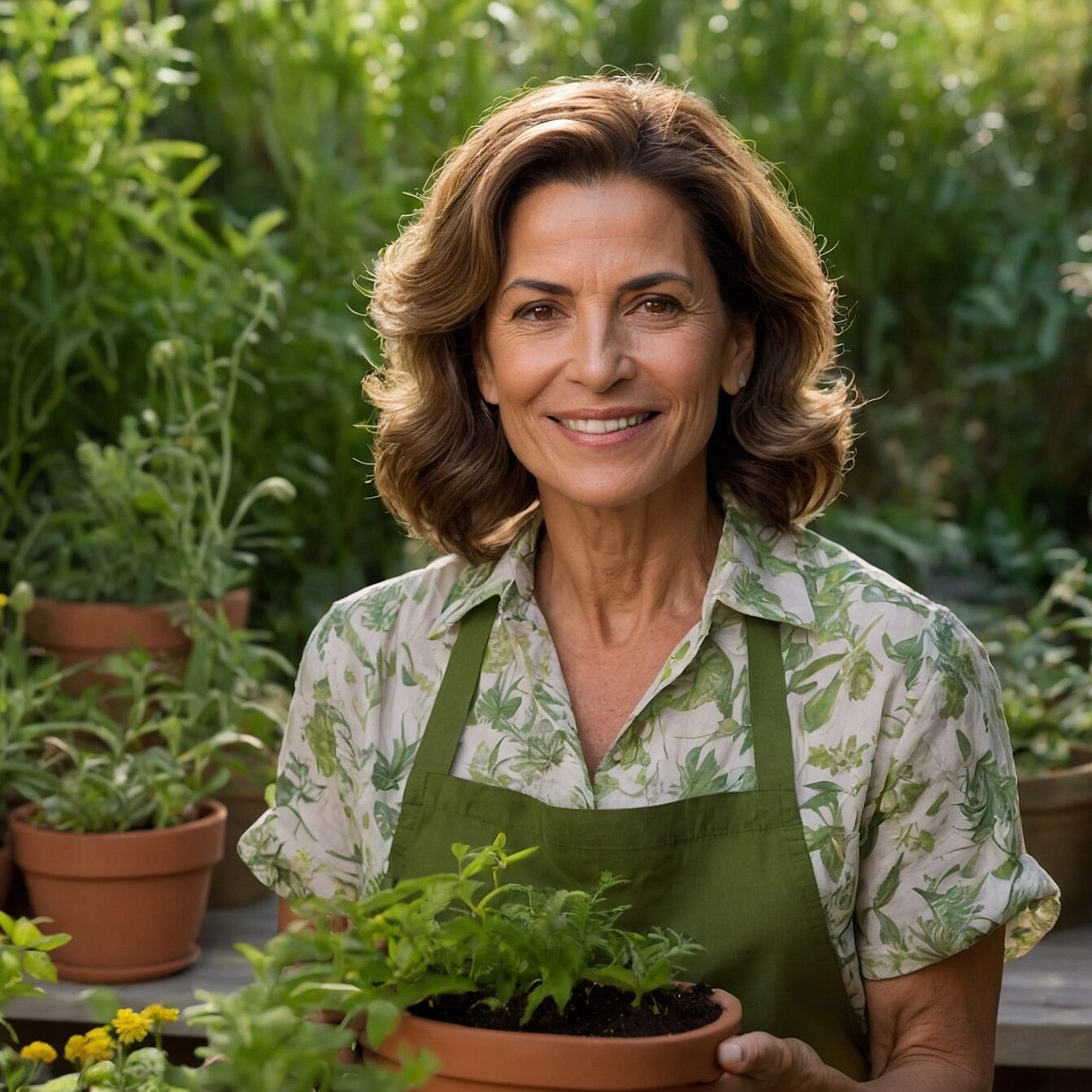Table of Contents
Introduction
Pending Shade Plants are a fantastic choice for those who want to add a touch of green to their surroundings, whether indoors or outdoors. The importance of hanging plants in decoration goes beyond their attractive aesthetics; they help to create a more welcoming and natural environment, making the most of the vertical space available.
The benefits of plants that thrive in shaded areas are numerous. These plants are ideal for places where direct sunlight is scarce, such as indoors, on covered verandas or under trees. Not only do they improve air quality by absorbing carbon dioxide and releasing oxygen, but they can also reduce stress and increase the general well-being of the people who live with them.
In this article, we’ll explore five hanging shade plants that are perfect for transforming any space. For each plant, we’ll discuss its description, care requirements and the benefits they bring. By the end, you’ll have a clear understanding of how to incorporate these plants into your decor and how to care for them so that they thrive.
1. Golden Pothos (Epipremnum aureum)
Description
Golden pothos, also known as Pothos, is a popular plant for its hardiness and easy maintenance. Its leaves have a distinctive heart shape and come in variations of green and yellow, adding a vibrant touch to any environment.
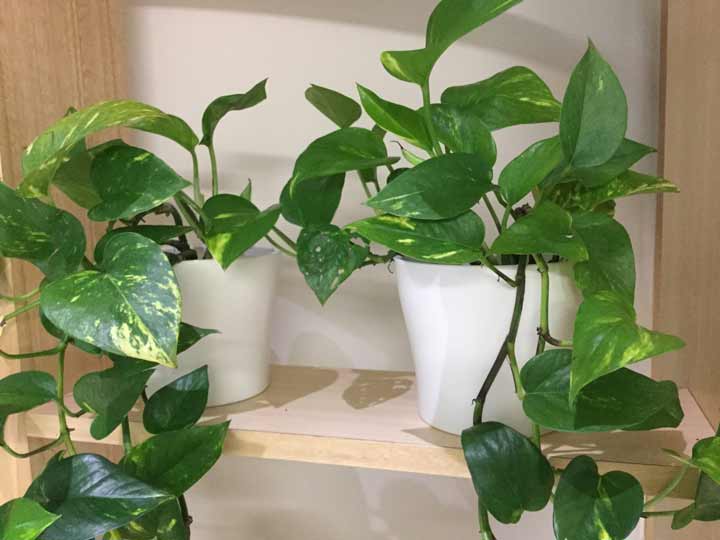
Care
- Light and watering requirements: Golden pothos prefers indirect light or partial shade and does not tolerate intense direct sunlight. As for watering, it is important to allow the soil to dry out between waterings to avoid root rot.
- Suitable soil and fertilization: Well-drained soil is essential for growing Golden pothos. In addition, light to moderate fertilization during spring and summer will help promote healthy growth.
Benefits
- Air purification and decorative versatility: In addition to its ornamental beauty, Golden pothos is known for its air purification abilities, removing toxins such as formaldehyde and benzene. Its ability to grow both in hanging pots and on trellises makes it a versatile choice for any space.
2. Rhipsalis (Rhipsalis spp.)
Description
Rhipsalis is a genus of hanging cacti with an exotic, slender appearance. Its most distinctive features are the long, cylindrical branches that create a unique texture, hanging gracefully from hanging baskets or tall pots.
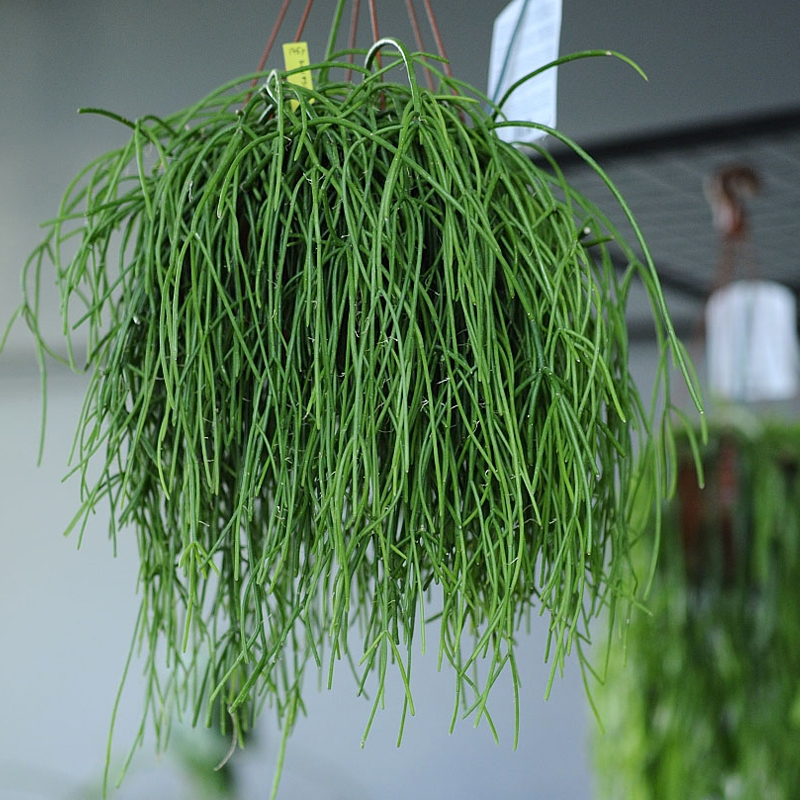
Care
- Needs indirect light and moderate watering: Rhipsalis prefers indirect light or partial shade, making it ideal for low-light areas. As for watering, it is important to keep the soil slightly moist, watering only when the top of the substrate is dry to the touch.
- Ideal substrate and fertilization: A well-drained substrate, such as a mixture of cacti and succulents, is suitable for growing Rhipsalis. Fertilize the plant monthly during spring and summer with a diluted balanced fertilizer.
Benefits
- Adding a tropical and elegant element to a space: With its pendulous growth and unique appearance, Rhipsalis adds a touch of exoticism and elegance to any environment. Its characteristics make it a perfect choice for those looking to create a tropical atmosphere indoors.
3. Fern (Nephrolepis exaltata)
Description
Fern is famous for its finely divided leaves and cascades of green, creating a lush and classic appearance. It is an excellent plant for hanging in baskets, where its leaves can spread freely, adding an atmosphere of freshness and tranquillity to the room.
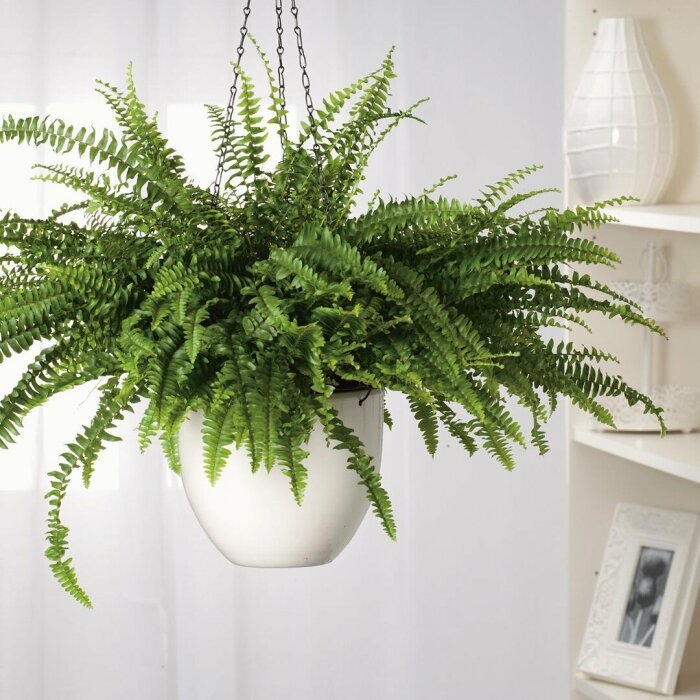
Care
- Humidity and diffused light preferences: Ferns thrive in environments with high humidity and indirect light. Keep the soil moist at all times, but avoid waterlogging, and position the plant in a place where it receives filtered light.
- Pruning and maintenance tips: Remove dead or damaged leaves regularly to keep the plant healthy and stimulate the growth of new fronds. Also, spray water on the leaves regularly to increase the humidity around the plant.
Benefits
- Improved air quality and classic beauty: In addition to their ornamental beauty, Ferns are known for their ability to purify the air, removing toxins such as formaldehyde and xylene. Their lush, classic foliage brings a sense of serenity and freshness to the environment.
4. Peperomia (Peperomia spp.)
Description
Peperomia is known for its leaves, which vary in shape and color from solid dark green to variegated with distinct patterns. This plant is compact and ideal for small spaces, making it perfect for those who want to add a touch of green to limited environments.
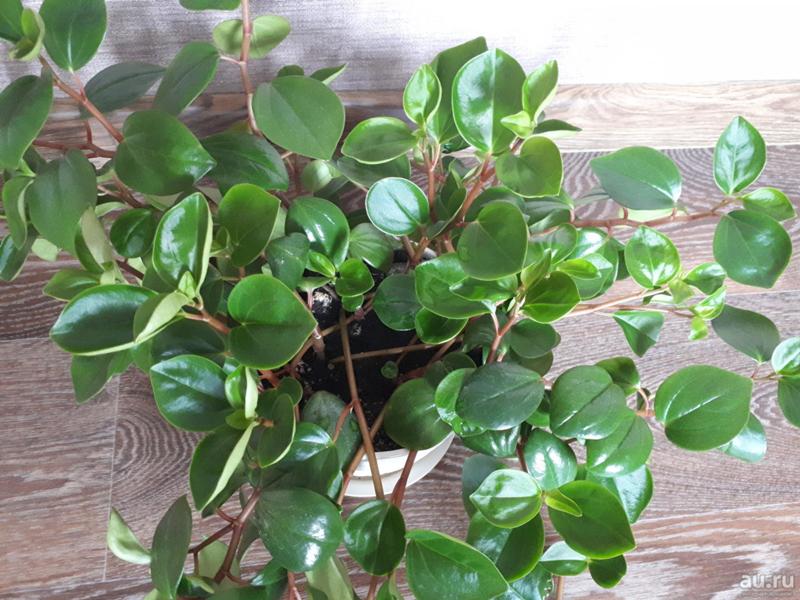
Care
- Low light requirements and controlled watering: Peperomia prefers indirect light or partial shade and should only be watered when the soil is dry on the surface. Avoid direct sunlight as it can damage the leaves.
- Suitable soil and fertilization: Use a well-drained, light soil, such as a potting mix for succulents, and fertilize the plant with a diluted liquid fertilizer monthly during spring and summer.
Benefits
- Ease of care and diverse options for decoration: Peperomia is a low-maintenance plant, perfect for beginners or those who have little time to look after plants. What’s more, its many varieties offer a wide range of decorative options, from indoors to protected outdoor areas.
5. Goldfish Plant (Nematanthus gregarius)
Description
The Goldfish Plant is a plant known for its bright fish-shaped flowers, which are highly ornamental and add a touch of charm and exoticism to the environment. Its bright green foliage also stands out in hanging baskets, creating a visually impressive display.
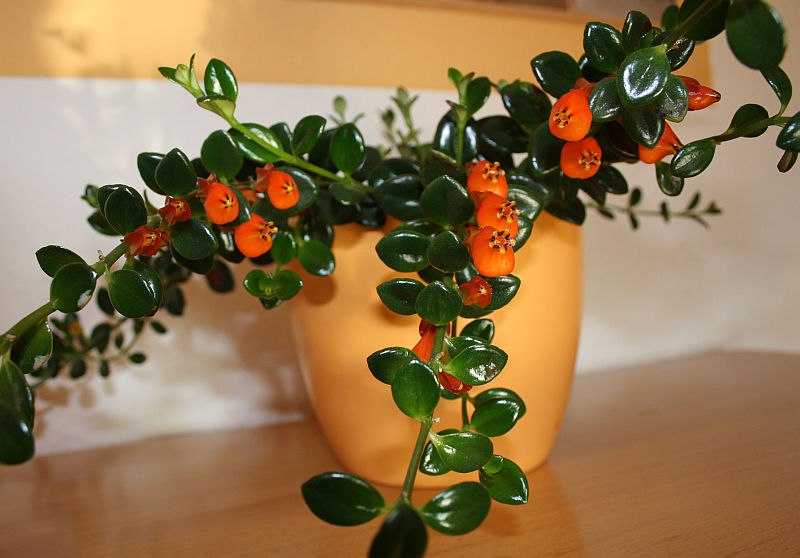
Care
- Needs indirect light and regular watering: The Goldfish Plant prefers indirect light or partial shade and should be watered regularly to keep the soil slightly moist. Avoid direct sunlight as it can damage the delicate leaves and flowers.
- Soil conditions and fertilization: Use well-drained soil rich in organic matter to grow the Goldfish Plant. Fertilize the plant monthly during spring and summer with a diluted balanced liquid fertilizer.
Benefits
- Exotic and colorful touch for shady interiors: In addition to its ornamental beauty, the Goldfish Plant adds an exotic and colorful touch to shady interiors. Its vibrant flowers and lush foliage bring life and joy to any space, making it a popular choice for those looking for a unique and captivating plant.
Conclusion Hanging Plants
All in all, hanging shade plants offer a number of benefits that make them an ideal choice for any environment. From adding greenery and freshness to purifying the air and creating a welcoming atmosphere, these plants have a lot to offer.
When considering interior and exterior decoration, incorporating hanging shade plants can be an effective way to transform a space and create a more pleasant and inviting atmosphere. Their unique characteristics and ornamental beauty can really make a difference to the aesthetics of any room.
What’s more, by caring for these plants, you can also learn to create a more welcoming and green environment. Additional tips, such as watering regularly, providing the right amount of light and choosing the right soil, are key to ensuring that your hanging shade plants thrive and bring even more beauty to your space.
So don’t hesitate to incorporate some of these hanging shade plants into your decor. With a little care and attention, you can enjoy a more vibrant, healthy and welcoming environment in your home or garden.
Frequently Asked Questions
Which plants don’t need sun?
Plants that don’t need full sun are generally species adapted to shady environments, such as Ferns, Peace Lilies and Marantas. These plants have developed mechanisms to thrive in conditions of diffused or indirect light, making them ideal for interiors with little sun exposure.
Which plants survive in the shade?
Among the plants that survive in the shade, Golden pothos, ripsalis and aspidistra stand out. These plants are known for their ability to thrive in environments with little natural light, making them popular choices for indoor spaces or shady outdoor areas.
Which hanging plant likes shade?
One shade-loving hanging plant is Fern. With its lush foliage and ability to thrive in low-light environments, Fern is an excellent choice for hanging baskets on covered balconies or indoor areas with limited lighting. Its delicate leaves add a touch of freshness and elegance to any shaded space.
